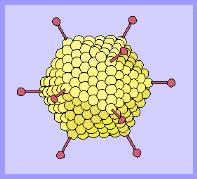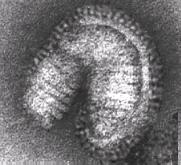|
|
|
What is the Virus that Causes Birdflu?
|
|
Regular strains of 'flu' results from either an Influenza A or B virus.
Influenza B only affects humans, however, influenza A can affect birds and
mammals, including humans.
All subtypes of Influenza A are found in birds, but only some types are
found in mammals.
|
 |
|
An exterior view of a virus, displaying the protein coat.
Linda M. Stanard, University of Cape Town
|
|
|
A virus particle is basically a nucleic acid enclosed in a protein shell or coat.
The Influenza A virus has a protein coat consisting of two separate surface proteins:
haemaglutin (H) and neuraminidase (N). Influenza viruses are classified
into subtypes based on these proteins, and the birdflu virus is known as H5N1.
Over time, changes can occur in these proteins, minor changes (termed antigenic drift)
or major changes (termed antigenic shift) can occur. The antibodies which our body produces to
give us immunity to viruses becmome less effective as more change occurs.
|
When an antigenic shift occurs, it results in a completely new virus, to which humans have little or
new immunity. This can become very serious if the virus is passed from human to human, hence adequate
treatments for the disease are required. If a treatment hasn't been developed, is difficult to synthesise,
or cannot be mass-produced quickly enough, then it becomes a large scale problem.
This is the basis for a worldwide pandemic, such as was seen in the case of the Spanish Flu pandemic of
1918, and the Asian Flu pandemic of 1957.
|
|
 |
|
An influenza virus under electron microscope.
Linda M. Stanard, University of Cape Town
|
|
|
BACK TO TOP
|
|